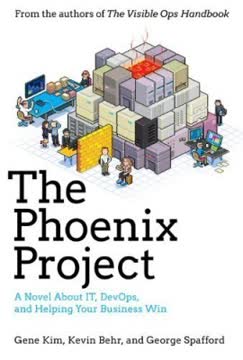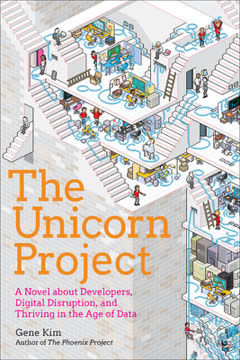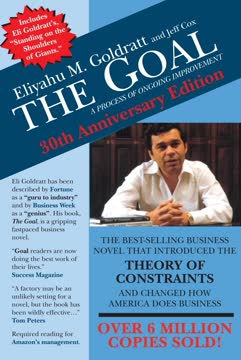نکات کلیدی
1. شناسایی محدودیت سیستم برای بهبود عملکرد کلی
"هدف درباره علم و آموزش است. من معتقدم که این دو کلمه به حدی مورد سوءاستفاده قرار گرفتهاند که معانی اصلی خود را در مهای از احترام بیش از حد و رمز و راز از دست دادهاند."
اصل گلوگاه. در هر سیستم پیچیدهای، همیشه یک محدودیت وجود دارد که عملکرد کلی را محدود میکند. این محدودیت یا گلوگاه، تعیینکنندهی جریان کل سیستم است. با شناسایی و تمرکز بر این محدودیت، مدیران میتوانند به طور چشمگیری عملکرد سازمانهای خود را بهبود بخشند.
مراحل شناسایی محدودیتها:
- تحلیل جریان کار در سیستم
- جستجوی مناطقی که کار به طور مداوم انباشته میشود
- اندازهگیری ظرفیت هر منبع در برابر تقاضا
- در نظر گرفتن محدودیتهای فیزیکی و سیاستی
کاربرد واقعی: در رمان، الکس روگو ماشین NCX-10 و کورهی حرارتی را به عنوان گلوگاههای اصلی در کارخانهاش شناسایی میکند. با تمرکز بر این محدودیتها، او قادر است عملکرد کارخانه را به طور قابل توجهی بهبود بخشد و آن را از تعطیلی نجات دهد.
2. تعادل جریان، نه ظرفیت، برای بهینهسازی تولید
"کارخانهای که در آن همه همیشه مشغول کار هستند، بسیار ناکارآمد است."
به چالش کشیدن تفکر سنتی. باور عمومی که حداکثر کردن کارایی هر منبع منجر به عملکرد بهینه میشود، نادرست است. در عوض، تمرکز باید بر تعادل جریان کار در کل سیستم باشد.
مفاهیم کلیدی:
- رویدادهای وابسته: مراحلی در یک فرآیند که باید به ترتیب خاصی انجام شوند
- نوسانات آماری: تغییرات طبیعی در زمانهای فرآیند و کیفیت
پیامدها:
- منابع غیرگلوگاهی نباید همیشه با ظرفیت کامل کار کنند
- ظرفیت اضافی در مناطق غیرگلوگاهی برای حفظ جریان ضروری است
- منابع گلوگاهی باید به طور کامل استفاده شوند تا عملکرد سیستم به حداکثر برسد
3. تابعیت همه چیز از محدودیت برای حداکثر کارایی
"یک ساعت از دست رفته در گلوگاه، یک ساعت از دست رفته برای کل سیستم است."
اولویتبندی محدودیت. پس از شناسایی محدودیت سیستم، همه منابع و فرآیندهای دیگر باید برای حمایت و به حداکثر رساندن کارایی محدودیت هماهنگ شوند.
مراحل عملی:
- اطمینان از اینکه گلوگاهها همیشه کار برای انجام دارند
- اجرای کنترل کیفیت قبل از گلوگاه برای جلوگیری از هدر رفتن زمان بر روی قطعات معیوب
- تنظیم برنامهها و اولویتها برای حفظ عملکرد گلوگاه
- تخصیص مجدد منابع برای حمایت از عملیات گلوگاه
مثال: در رمان، الکس سیستم "برچسب قرمز" را برای اولویتبندی کار برای منابع گلوگاهی پیادهسازی میکند، اطمینان حاصل میکند که آنها هرگز به دلیل کمبود مواد یا حمایت بیکار نمیمانند.
4. بهرهبرداری از محدودیت به حداکثر پتانسیل آن
"فعالسازی یک منبع و استفاده از یک منبع مترادف نیستند."
به حداکثر رساندن کارایی گلوگاه. قبل از سرمایهگذاری در ظرفیت اضافی، اطمینان حاصل کنید که محدودیت فعلی به حداکثر پتانسیل خود استفاده میشود.
استراتژیهای بهرهبرداری:
- حذف زمان غیرمولد (مانند استراحتها، تنظیمات) در گلوگاه
- بهبود کیفیت ورودیها به گلوگاه
- انتقال کار از گلوگاه به منابع غیرگلوگاهی در صورت امکان
- تمرکز بر بهبود کارایی گلوگاه از طریق آموزش و بهبود فرآیندها
مثال واقعی: کارخانه در رمان برنامههای جدید استراحت و اقدامات کنترل کیفیت را پیادهسازی میکند تا اطمینان حاصل شود که ماشینهای گلوگاهی همیشه مولد هستند.
5. ارتقاء محدودیت تنها پس از اتمام سایر مراحل
"هر بار که یک گلوگاه یک قطعه را به پایان میرساند، شما امکان ارسال یک محصول نهایی را فراهم میکنید."
گسترش استراتژیک ظرفیت. پس از بهرهبرداری کامل از محدودیت فعلی، در نظر بگیرید که در ظرفیت اضافی سرمایهگذاری کنید تا محدودیت را ارتقاء دهید.
ملاحظات قبل از ارتقاء:
- اطمینان از اینکه همه مراحل قبلی به طور کامل اجرا شدهاند
- تحلیل تأثیر بالقوه بر کل سیستم
- در نظر گرفتن راهحلهای جایگزین (مانند برونسپاری، ارتقاء فناوری)
- ارزیابی پیامدهای مالی سرمایهگذاری
احتیاط: ارتقاء محدودیت ممکن است گلوگاه را به بخش دیگری از سیستم منتقل کند، که نیاز به ارزیابی مجدد کل فرآیند دارد.
6. مراقب اینرسی باشید: به طور مداوم محدودیتها را ارزیابی کنید
"هشدار!!!! اگر در مراحل قبلی یک محدودیت شکسته شده است، به مرحله 1 برگردید، اما اجازه ندهید اینرسی باعث ایجاد محدودیت سیستم شود."
فرآیند بهبود مداوم. با رفع و حل محدودیتها، گلوگاههای جدیدی ظاهر خواهند شد. بسیار مهم است که به طور مداوم محدودیتهای جدید را ارزیابی و شناسایی کنید تا عملکرد بهینه حفظ شود.
نشانههای اینرسی:
- ادامه تمرکز بر گلوگاههای قدیمی که دیگر محدودیت نیستند
- حفظ سیاستها یا رویههایی که برای محدودیتهای قبلی طراحی شدهاند
- عدم تشخیص تغییرات در تقاضای بازار یا فشارهای رقابتی
مثال: در رمان، الکس متوجه میشود که پس از بهبود کارایی کارخانه، بازار به محدودیت جدید تبدیل میشود و نیاز به تغییر تمرکز به استراتژیهای فروش و بازاریابی دارد.
7. پیادهسازی نظریه محدودیتها (TOC) برای بهبود مداوم
"فرآیندی برای بهبود مداوم."
رویکرد سیستماتیک به بهبود. نظریه محدودیتها چارچوبی برای بهبود مداوم در سازمانها ارائه میدهد که با تمرکز بر شناسایی و رفع محدودیتها انجام میشود.
پنج مرحله تمرکز TOC:
- شناسایی محدودیت
- بهرهبرداری از محدودیت
- تابعیت همه چیز دیگر
- ارتقاء محدودیت
- تکرار فرآیند
مزایای پیادهسازی TOC:
- بهبود جریان و سودآوری
- کاهش موجودی و هزینههای عملیاتی
- افزایش قابلیتهای حل مسئله
- افزایش تمرکز و هماهنگی سازمانی
8. به چالش کشیدن روشهای سنتی حسابداری هزینه برای تصمیمگیری بهتر
"همه چیزهایی که در پروندههایم نگه میداشتم داده است. آنچه معمولاً میخواهید اطلاعات است."
بازنگری معیارهای مالی. روشهای سنتی حسابداری هزینه میتوانند با تمرکز بر کاراییهای محلی به جای عملکرد کلی سیستم، به تصمیمگیریهای نامطلوب منجر شوند.
مشکلات حسابداری سنتی:
- تأکید بر کاهش هزینه به جای افزایش جریان
- تخصیص نادرست هزینههای سربار
- تشویق به موجودی اضافی برای بهبود معیارهای "کارایی"
معیارهای جایگزین برای در نظر گرفتن:
- جریان (درآمد منهای هزینههای واقعاً متغیر)
- موجودی (پولی که در سیستم گیر کرده است)
- هزینه عملیاتی (پولی که برای تبدیل موجودی به جریان خرج میشود)
مثال: در رمان، الکس محاسبات سنتی هزینه محصول را به چالش میکشد، که منجر به تصمیمات قیمتگذاری و تولید سودآورتر میشود.
9. تمرکز بر جریان، نه فقط کاهش هزینه، برای افزایش سود
"هدف یک سازمان تولیدی کسب درآمد است."
تغییر تمرکز به تولید درآمد. در حالی که کاهش هزینه مهم است، افزایش جریان (نرخی که سیستم از طریق فروش پول تولید میکند) اغلب تأثیر بیشتری بر سودآوری دارد.
استراتژیها برای افزایش جریان:
- شناسایی و بهرهبرداری از محدودیتهای بازار
- بهبود ترکیب محصول برای تمرکز بر اقلام با حاشیه بالا
- کاهش زمانهای تحویل برای کسب سهم بیشتر از بازار
- توسعه محصولات یا خدمات جدید برای گسترش بازار
تأثیر مالی: افزایش جریان اغلب تأثیر بیشتری بر خط پایین دارد تا کاهش هزینههای معادل، همانطور که موفقیت الکس در بهبود عملکرد کارخانه نشان میدهد.
10. استفاده از روش سقراطی برای ایجاد تغییرات سازمانی
"اگر به سادگی به شما بگویم چه کاری انجام دهید، در نهایت شکست خواهید خورد. شما باید خودتان درک کنید تا قوانین کار کنند."
پرورش تفکر انتقادی. روش سقراطی با پرسیدن سوالات کاوشگرانه افراد را تشویق میکند تا خودشان راهحلها را کشف کنند، که منجر به درک عمیقتر و تعهد به تغییر میشود.
مزایای رویکرد سقراطی:
- تشویق به تفکر انتقادی و حل مسئله
- ایجاد مالکیت و تعهد به راهحلها
- به چالش کشیدن فرضیات و باورهای ریشهدار
- ترویج یادگیری و بهبود مداوم
کاربرد: در طول رمان، جونا از روش سقراطی برای هدایت الکس و تیمش به کشف راهحلها استفاده میکند، به جای اینکه به سادگی پاسخها را ارائه دهد.
11. بهکارگیری تفکر علمی در مدیریت برای موفقیت پایدار
"علم برای من و برای اکثریت دانشمندان محترم، درباره اسرار طبیعت یا حتی درباره حقایق نیست. علم صرفاً روشی است که ما برای تلاش و فرضیهسازی مجموعهای حداقلی از فرضیات استفاده میکنیم که میتواند از طریق استنتاج منطقی ساده، وجود بسیاری از پدیدههای طبیعت را توضیح دهد."
مدیریت به عنوان یک علم. بهکارگیری تفکر علمی در مدیریت شامل توسعه فرضیهها، آزمایش فرضیات و بهطور مداوم اصلاح نظریهها بر اساس شواهد است.
عناصر کلیدی مدیریت علمی:
- به وضوح تعریف مشکلات و اهداف
- توسعه فرضیههای قابل آزمایش
- جمعآوری و تحلیل دادهها
- نتیجهگیری منطقی
- پیادهسازی و نظارت بر راهحلها
- بهطور مداوم اصلاح و بهبود
تأثیر بلندمدت: با اتخاذ رویکرد علمی به مدیریت، سازمانها میتوانند استراتژیهای قوی و قابل انطباقی را توسعه دهند که منجر به موفقیت پایدار در محیطهای تجاری پویا میشود.
آخرین بهروزرسانی::
FAQ
What's The Goal by Eliyahu M. Goldratt about?
- Manufacturing Focus: The Goal is a business novel that follows Alex Rogo, a plant manager, as he works to save his manufacturing plant from closure by applying the Theory of Constraints (TOC).
- Theory of Constraints: The book introduces TOC, a management philosophy that emphasizes identifying and managing bottlenecks to improve production efficiency.
- Narrative Style: Goldratt uses a narrative approach to explain complex concepts, making them accessible to readers without a technical background.
- Organizational Goal: The central theme is that the primary goal of any organization, especially in manufacturing, is to make money by increasing throughput and reducing inventory and operational expenses.
Why should I read The Goal by Eliyahu M. Goldratt?
- Practical Insights: The book offers practical insights into improving manufacturing efficiency and productivity, valuable for managers and business leaders.
- Engaging Storytelling: Goldratt's narrative style keeps readers engaged, blending fiction with educational content for a deeper understanding of the concepts.
- Timeless Principles: The principles discussed are applicable across various industries, not just manufacturing, and can improve organizational and personal productivity.
- Foundation for TOC: Reading The Goal provides a foundational understanding of the Theory of Constraints, leading to significant improvements in productivity and profitability.
What are the key takeaways of The Goal by Eliyahu M. Goldratt?
- Theory of Constraints: Every system has at least one constraint that limits its performance; identifying and managing these constraints is crucial for improvement.
- Three Measurements: Goldratt introduces throughput, inventory, and operational expense as critical metrics for assessing manufacturing health.
- Focus on Flow: The book emphasizes balancing flow rather than capacity to manage bottlenecks effectively and meet market demand.
- Continuous Improvement: TOC promotes a cycle of continuous improvement, adapting to changing conditions to enhance performance over time.
What is the Theory of Constraints in The Goal by Eliyahu M. Goldratt?
- Definition: TOC is a management philosophy focusing on the most critical limiting factor (constraint) that hinders achieving a goal, often related to production bottlenecks.
- Five Focusing Steps: TOC involves identifying, exploiting, subordinating, elevating constraints, and repeating the process for continuous improvement.
- Holistic View: It encourages a holistic view of the organization, considering all parts of the system in relation to the constraint to prevent local optimizations that harm overall performance.
How does The Goal by Eliyahu M. Goldratt address the concept of bottlenecks?
- Identification: The book stresses identifying bottlenecks, resources whose capacity is equal to or less than the demand placed upon them.
- Management: Once identified, bottlenecks should be managed to ensure full capacity utilization, possibly by prioritizing work or reallocating resources.
- System Impact: Bottlenecks determine the performance of the entire system; mismanagement can lead to increased inventory and operational expenses, affecting profitability.
What are the three measurements introduced in The Goal by Eliyahu M. Goldratt?
- Throughput: Defined as the rate at which the system generates money through sales, emphasizing the importance of selling products for financial success.
- Inventory: Represents all the money invested in purchasing things intended to sell, highlighting the need to manage inventory levels to avoid excess costs.
- Operational Expense: The total money spent to turn inventory into throughput, crucial for understanding the overall efficiency of the manufacturing process.
What are the best quotes from The Goal by Eliyahu M. Goldratt and what do they mean?
- "The goal of a manufacturing organization is to make money.": Emphasizes that all activities should contribute to financial success, focusing on profitability over efficiency.
- "Throughput is the rate at which the system generates money through sales.": Highlights the importance of sales in measuring productivity, shifting focus from production to sales-driven revenue.
- "You can’t manage what you don’t measure.": Underscores the necessity of clear measurements to assess performance, essential for identifying problems and tracking improvements.
How does The Goal by Eliyahu M. Goldratt illustrate the importance of teamwork?
- Collaboration: Teamwork is essential for overcoming challenges and achieving organizational goals, with characters working together to identify bottlenecks and implement solutions.
- Shared Responsibility: Emphasizes that everyone has a role in achieving the goal, with individual actions impacting overall success.
- Communication and Trust: Effective communication and trust among team members are crucial for implementing changes and addressing issues, leading to a productive work environment.
What challenges does Alex Rogo face in The Goal by Eliyahu M. Goldratt?
- Plant Closure Threat: Alex faces the threat of his plant being shut down due to poor performance, driving him to seek solutions to save the plant and protect jobs.
- Work-Life Balance: He struggles to balance his demanding job with family life, leading to personal conflicts and emotional strain.
- Resistance to Change: Alex encounters resistance from management and employees when implementing new ideas, a significant challenge in shifting the plant's culture.
How can I apply the lessons from The Goal by Eliyahu M. Goldratt to my own work?
- Identify Constraints: Start by identifying constraints in your work processes, such as bottlenecks or inefficiencies, to understand areas for improvement.
- Focus on the Goal: Align actions and decisions with the primary goal of your organization, whether it's making money or improving customer satisfaction.
- Continuous Improvement: Adopt a mindset of continuous improvement, regularly evaluating processes and encouraging collaboration and open communication for a culture of improvement.
How can the concepts in The Goal by Eliyahu M. Goldratt be applied to other industries?
- Universal Principles: TOC principles apply to any industry involving processes and resource management, such as healthcare and supply chain management.
- Process Optimization: Use insights from the book to streamline operations, improve efficiency, and enhance customer satisfaction, leading to increased profitability.
- Cultural Shift: Implementing TOC often requires a cultural shift, encouraging collaboration, continuous improvement, and a focus on overall goals rather than localized efficiencies.
What role does management play in the success of the concepts in The Goal by Eliyahu M. Goldratt?
- Leadership and Vision: Effective management sets a clear vision and direction, communicating the importance of TOC principles and fostering a culture of improvement.
- Empowering Employees: Managers should empower employees to take ownership of their work and contribute to problem-solving efforts, essential for implementing TOC concepts.
- Monitoring and Adapting: Continuous monitoring of performance metrics and adapting strategies as needed ensures responsiveness to changing conditions and sustained improvements.
نقد و بررسی
کتاب هدف بهخاطر رویکرد جذابش در روایت داستان و آموزش مفاهیم کسبوکار مانند نظریه محدودیتها، نقدهای عمدتاً مثبتی دریافت کرده است. خوانندگان از بینشهای عملی آن در زمینه فرآیندهای تولید، گلوگاهها و بهینهسازی خروجی تقدیر کردهاند. بسیاری آن را چشمگشایی و قابلاستفاده فراتر از صرفاً تولید دانستهاند. برخی به نقشهای جنسیتی قدیمی و توسعه ضعیف شخصیتها انتقاد کردهاند. بهطور کلی، منتقدان از این که قالب رمان باعث دسترسی به ایدههای پیچیده شده، قدردانی کردهاند، هرچند عدهای احساس کردهاند که روایت ممکن است حواسپرتکن یا خستهکننده باشد. این کتاب بهعنوان یک کلاسیک در ادبیات مدیریت عملیات شناخته میشود.
Similar Books



















